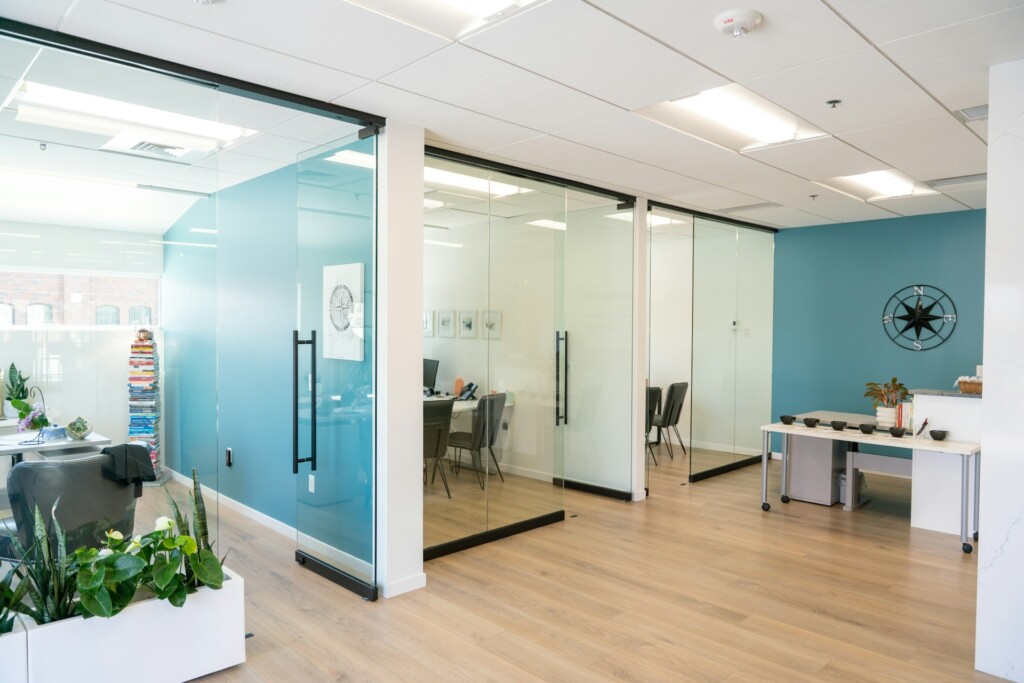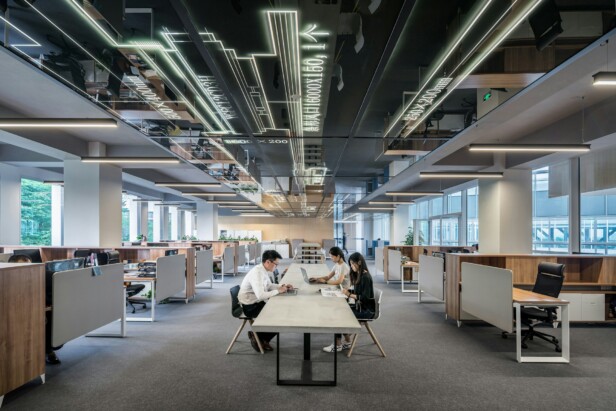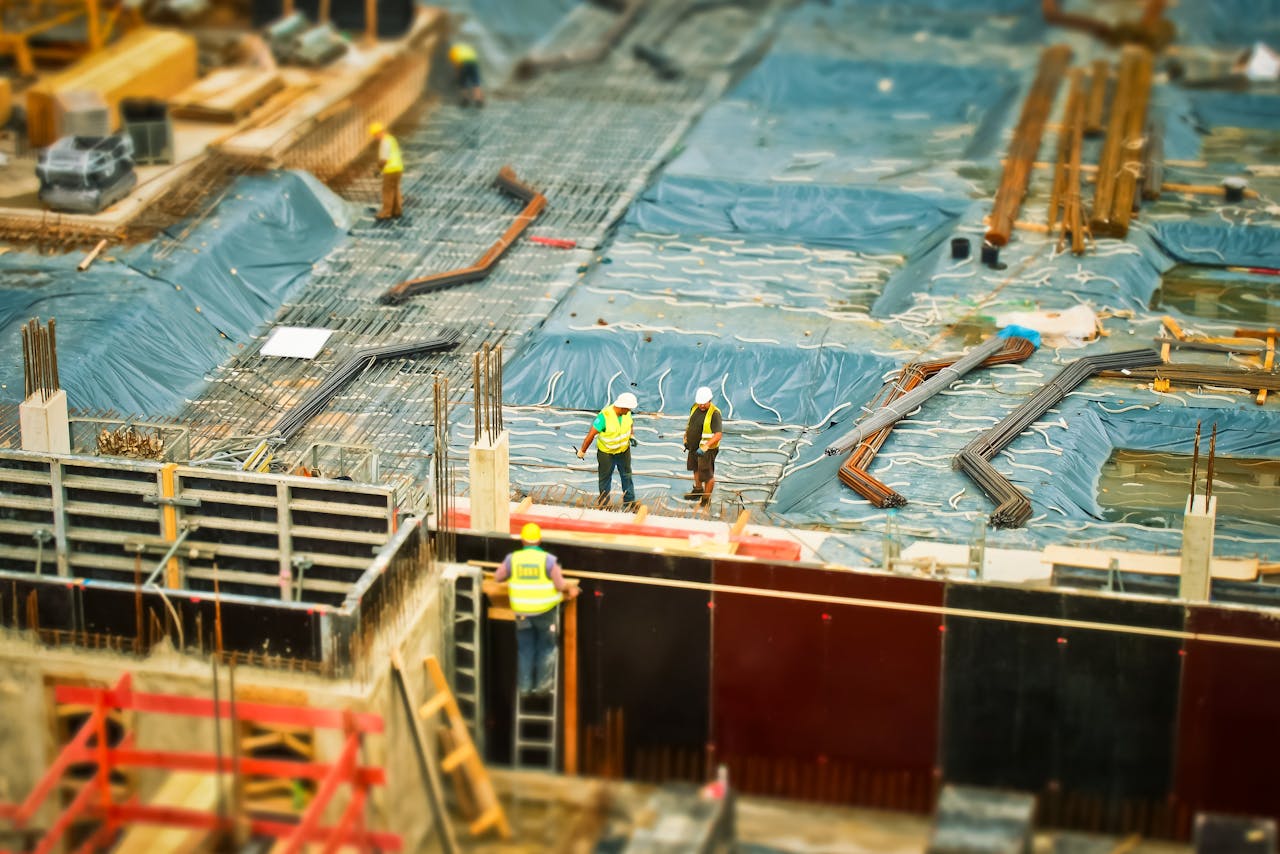Dallas office tenant improvement projects reveal a consistent pattern. Open office plans that look promising in design often stumble during execution, creating costly delays and operational headaches.
We see this across Downtown Dallas and Uptown projects where teams underestimate the complexity of acoustic treatments, sight lines, ADA compliance, and building permits. The scope extends beyond cosmetic updates to include HVAC zoning, structured cabling, and coordinated inspections that demand careful sequencing and technical expertise.
How Do Layout, Acoustics, And HVAC Planning Affect Open Offices?

Open office layouts create inherent challenges that demand strategic coordination. Without proper planning, these spaces amplify noise propagation while reducing privacy for occupants.
Managing Sound And Sight Lines Through Strategic Layout
We coordinate sight lines and acoustic treatments as fundamental elements during layout development. Clear sight lines support supervision and natural light distribution, but they also allow sound to travel freely across work areas. Acoustic treatments become essential to control this transmission.
Balance zones by combining collaborative areas with enclosed conference rooms and private offices. This mixed approach provides noise refuges while maintaining the collaborative benefits of open design. Demountable partitions offer flexibility to adjust these zones as needs change over time.
Glass Partitions For Light And Privacy Balance
Glass partitions help define space while preserving light penetration and visual connections. These systems control noise propagation more effectively than completely open layouts while maintaining the transparency that clients expect. Demountable glass partitions improve workspace acoustics by managing ambient noise levels.
We position glass partitions to create collaboration zones separated from focused work areas. This approach reduces distractions while supporting team interaction when needed.
HVAC Zone Controls For Thermal Comfort
Plan HVAC early in the design process, particularly for Dallas projects. Open offices require ductwork modifications and zone controls to manage comfort across large, shared areas effectively. Without proper zoning, energy costs rise as systems work harder to compensate for hot and cold spots.
We coordinate HVAC zones with space programming during design development. Conference rooms, collaboration zones, and workstation areas each require different comfort parameters. Early ductwork adjustments prevent costly modifications later in construction and ensure thermal comfort across all zones.
What Code, ADA, And Permitting Issues Commonly Cause Rework?
Open office reconfiguration projects frequently encounter compliance challenges that force expensive rework and timeline extensions. We see projects stall when teams treat code requirements as afterthoughts rather than design drivers. The key compliance areas that demand early attention include ADA accessibility standards, egress path requirements, fire safety systems, and local permitting processes.
ADA Door Hardware And Route Planning
Door modifications in open office projects commonly trigger ADA compliance issues. We coordinate door width requirements early in design, ensuring minimum 32-inch clear openings where ADA compliance applies. Hardware selection matters equally. Round doorknobs prevent access for people who cannot grasp or turn handles, requiring lever-style hardware in accessible routes.
Accessible route planning becomes complex when removing walls or reconfiguring spaces. Clear width requirements, maneuvering clearances, and pathway slopes must align with ADA standards throughout the space. Changes in floor level, even small transitions above half an inch, can create barriers that require costly rework if discovered during construction.
Fire Safety And Life Safety System Coordination
Fire safety modifications often catch teams off guard during open office conversions. Removing walls can affect fire ratings, compartmentalization, and sprinkler coverage patterns. We coordinate with fire protection engineers early to understand how space reconfigurations impact existing systems.
Emergency lighting and exit signage require careful review when layouts change. Egress paths must maintain proper widths and travel distances to exits. Projects frequently encounter rework when teams discover that proposed layouts exceed maximum travel distances or create dead-end corridors that violate life safety codes.
Sprinkler system modifications represent another common rework trigger. Head spacing, coverage patterns, and pipe routing often need adjustment when walls move or spaces open up. Planning these changes during design prevents the costly surprise of discovering inadequate coverage during final inspections.
Dallas Building Code Reviews And Permit Coordination
Late code reviews create the most expensive rework scenarios. We engage with City of Dallas plan reviewers early in the design process, submitting preliminary drawings for feedback before finalizing construction documents. This approach identifies potential issues while changes remain inexpensive to implement.
Common permit submission errors include incomplete accessibility compliance documentation, missing structural calculations for wall removals, and inadequate mechanical system modifications. Each resubmission extends timelines and increases carrying costs. We maintain detailed checklists aligned with Dallas building codes to ensure complete initial submissions.
Inspection scheduling becomes critical once construction begins. Dallas inspection windows require advance coordination, particularly for concealed work like electrical rough-in and mechanical installations. Projects that fail inspections face delays while corrections are completed and re-inspections scheduled.
Code compliance works best when treated as a design input rather than a construction constraint. We integrate compliance requirements into early design decisions, allowing code considerations to inform space planning rather than limit it. This proactive approach prevents the change orders and delays that plague projects where compliance becomes an afterthought.
Where Do Schedules And Budgets Go Off Track In Dallas Open-Plan Build-Outs?

Dallas open-plan build-outs encounter scheduling delays when teams rush construction starts before design documentation reaches completion. We consistently see projects drift from timelines when contractors begin demolition or infrastructure work with incomplete drawings, leading to rework and change orders that compound throughout the construction phase.
Lead times create another common scheduling trap. We track material delivery schedules closely because open office furniture systems, glass partitions, and specialized acoustic panels often require 8-12 weeks for manufacturing and delivery. Teams that overlook these lead times find themselves with completed construction but empty spaces waiting for critical components.
Inspection Windows And Phase Planning
Inspection scheduling represents a critical control point that many teams handle too late in the process. We coordinate with Dallas building inspection officials early to establish realistic inspection windows for electrical, mechanical, and life safety systems. Late inspection requests can add 1-2 weeks to project timelines when inspectors face full schedules.
Phase planning helps manage these inspection windows while maintaining construction momentum. We sequence work to allow inspections at natural completion points rather than forcing inspectors to evaluate incomplete systems. This approach reduces callbacks and keeps projects moving toward occupancy deadlines.
Furniture delivery alignment requires careful coordination with actual construction readiness rather than projected completion dates. We see teams schedule furniture installations based on optimistic timelines, then pay storage and redelivery fees when spaces remain unready for occupancy.
Budget Benchmarks And Contingency Planning
Moderate Dallas office build-outs featuring mostly open office plans average approximately $227 per square foot based on current market conditions. This figure reflects standard finishes, basic acoustic treatments, and typical infrastructure modifications across the Dallas-Fort Worth metroplex. Basic scopes with minimal customization range from $40-75 per square foot, while high-end build-outs with premium finishes and extensive customization reach $150-300 per square foot.
We recommend maintaining a 10-20% contingency for Dallas projects because concealed conditions and scope creep occur regularly in commercial tenant improvements. Older downtown buildings often reveal unexpected structural or mechanical conditions during demolition, while newer suburban spaces typically require smaller contingencies due to better-documented existing systems.
Change orders represent the primary budget risk we manage throughout construction. These modifications arise from design changes, unforeseen conditions, or updated client requirements that emerge during the construction process. Effective change order management requires clear documentation and prompt decision-making to minimize schedule impacts.
TI Allowance Coordination And Milestone Disbursements
Dallas Class A office spaces typically provide tenant improvement allowances ranging from $25-55 per square foot, with most transactions settling between $30-50 per square foot. We align build-out scope with available TI allowance terms to prevent cost overruns that strain project budgets and require additional tenant funding.
Milestone-based disbursements help manage cash flow while ensuring construction progress meets agreed schedules. We structure these payments around key completion points: permit approval, substantial completion of infrastructure work, and final occupancy readiness. This approach provides regular funding while maintaining quality control throughout the construction process.
Lease alignment becomes critical when coordinating TI allowance disbursements with construction milestones. We work with property owners to establish payment schedules that support construction cash flow requirements while meeting landlord documentation and approval processes for allowance releases.
What Tech And Infrastructure Gaps Undermine Open-Concept Performance?
Tech planning delays create expensive rework cycles. We see insufficient electrical outlets, inadequate Wi-Fi coverage, and audio-visual systems that refuse to integrate properly. Missing data drops force crews to backtrack through finished ceilings, and undersized electrical panels trigger costly upgrades mid-construction.
Power distribution requires upfront coordination across collaboration zones and focus rooms. Open-concept spaces demand outlets at every workstation cluster plus dedicated circuits for high-demand AV equipment. We plan power loads early to avoid panel capacity shortfalls that delay final occupancy.
Structured Cabling Coordination Prevents Major Delays
Structured cabling forms the backbone of any functional open office. Structured cabling systems include data drops, fiber optic connections, and pathways that support current needs while reserving capacity for future expansion. Coordination between the final layout and cable routing prevents conflicts during installation.
We position wireless access points based on the completed floor plan, not preliminary sketches. Coverage gaps appear when AP locations get locked in before furniture layouts are finalized. Fiber optic connections require clear pathways from telecom rooms to equipment locations, and these routes need protection during construction phases.
Cable management becomes critical in open environments where everything remains visible. We use structured pathways through ceiling spaces and coordinate conduit sizing to handle both current loads and future technology infrastructure needs.
AV Integration Gaps Create Functionality Problems
AV integration failures stem from late coordination between systems. Video conferencing equipment, digital displays, and sound systems each require dedicated power, data connections, and mounting infrastructure. We coordinate these requirements during rough-in phases to avoid conflicts with HVAC and structural elements.
Hybrid work patterns demand seamless switching between in-person and remote collaboration. This requires cameras positioned for optimal viewing angles, microphone coverage across meeting areas, and display systems visible from various seating arrangements. Poor AV planning forces uncomfortable compromises in furniture placement and room functionality.
Control systems need integration across lighting, displays, and room booking platforms. We specify compatible systems early and test integrations before final commissioning to ensure smooth operation at occupancy.
Future-Proofing Through Capacity Planning
Panel capacity and pathway sizing determine long-term flexibility. We reserve 25-30% spare capacity in electrical panels and telecommunications rooms to accommodate future equipment additions. Conduit and cable tray systems get sized for expansion rather than minimum current requirements.
Hybrid work technology continues evolving, requiring adaptable infrastructure. We install extra data drops in collaboration zones and reserve ceiling space for future wireless access points. This prevents disruptive retrofits when technology needs change or expand.
Technology infrastructure planning coordinates with mechanical and electrical trades from project start. Early coordination prevents the conflicts that force expensive field changes and schedule delays.
Conclusion: Build Open Offices That Work—Quietly, Compliantly, And On Schedule

We’ve seen too many Dallas open-concept projects stumble because teams treated these challenges as afterthoughts rather than design fundamentals. The difference between a successful build-out and one that drags through change orders comes down to front-loading the technical decisions. Start with acoustic planning and HVAC zoning in your initial design phases, not when the drywall goes up. Run your ADA compliance reviews and permit submissions before you touch a demolition hammer. These early investments in planning prevent the expensive corrections that derail schedules and budgets.
Quality control in open office construction requires coordinating multiple systems from day one. We align IT infrastructure planning with architectural layouts, ensuring power distribution matches collaboration zones while structured cabling supports current and future technology needs. Stakeholder coordination becomes critical when managing the interdependencies between mechanical systems, electrical rough-in, and technology infrastructure. Use milestone-based disbursements tied to your tenant improvement allowance terms, maintain that 10-20% project contingency for concealed conditions, and schedule inspections well ahead of critical path deadlines. This systematic approach to change management reduces rework, improves occupant comfort, and delivers the functional workspace your tenants expect. Contact EB3 Construction to ensure your next open-concept office project stays on track from design through occupancy.




